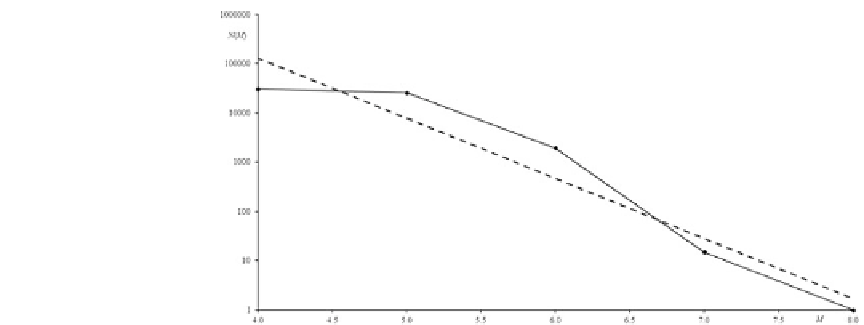Geology Reference
In-Depth Information
Fig. 10.19
Fit of the
Gutenberg-Richter
distribution (
dashed line
)
to the population of
earthquakes in the global
CMT catalog 1976-2009
(
solid line
). The best-fitting
value of
b
is
1.22
recognize that such relation could be described
by a power-law:
are no earthquakes. Molnar (
1979
) has proved
that if
M
0,max
is the maximum observed seismic
moment, then the annual rate of scalar moment
release is given by:
log
10
N.M/
D
a
bM
(10.62)
'
where
N
(
M
) is the number of earthquakes with
magnitude greater than or equal to an assigned
value
M
in some time interval and region. An
example of modelling of the global seismicity by
this law is illustrated in Fig.
10.19
.
In expression (
10.62
), the parameter
a
depends
from the total number of events with magnitude
greater than or equal to zero, while
b
measures the
relative number of large earthquakes versus small
earthquakes. This parameter is referred to as the
b
-
value
and varies between 0.8 and 1.2 for a
number of different regions. In seismically active
regions, it is close to the unity. A
b
-value of 1
implies that for each unitary magnitude increase,
there is a tenfold reduction in the number of
earthquakes.
An empirical relation similar to the Gutenberg-
Richter law holds for the seismic moment
M
0
.In
this instance, the annual number of earthquakes
with seismic moment greater than or equal to
an assigned value
M
0
in some tectonic region is
given by (Molnar
1979
):
M
0
D
1
“
M
1“
(10.64)
0;max
As pointed out by Kagan (
1991
), there is
evidence that the “-value represents a universal
constant. At global scale, a statistical analysis of
the CMT catalog gives “
D
2/3. Although this
is also the value suggested by Molnar (
1979
),
theoretical arguments lead to the value “
D
0.5
for any specific tectonic region (Kagan
1991
,
1993
,
2010
). We shall see in the next chapter that
(
10.63
)and(
10.64
) play a key role in the study of
the seismic deformation of the lithosphere.
Problems
1. An active fault has been mapped by geol-
ogists. After the last earthquake, they have
found that its length is 10 km, the strike
is ¥
D
30
ı
N, the dip is •
D
45
ı
,anaverage
10 cm downward dip-slip displacement of the
hanging wall occurred, while seismic reflec-
tion studies suggest that the fault reaches a
depth of 5 km. Estimate the moment tensor
components for this earthquake;
2. Prove the validity of expression (
10.58
)forthe
moment tensor components;
N.M
0
/
D
'M
“
(10.63)
0
where ' and “ are constants. This distribution
does not take into account the important obser-
vation that for any given tectonic region there is
a threshold seismic moment above which there



